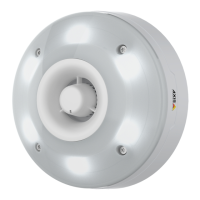
Do you have a question about the Axis D4100-E and is the answer not in the manual?
| Model | D4100-E |
|---|---|
| IK Rating | IK10 |
| Frame Rate | 30 fps |
| Lens | 2.8 mm, F2.0 |
| Compression | H.264 |
| Power Source | PoE (IEEE 802.3af) |
| Wide Dynamic Range | Yes |
| Day/Night | Yes (mechanical IR cut filter) |
| Onboard Storage | microSD/microSDHC/microSDXC card |
| Supported Protocols | IPv4, IPv6, HTTP, HTTPS, FTP, SMTP, Bonjour, UPnP, SNMP, DNS, NTP, RTSP, RTP, TCP, UDP, IGMP, ICMP, DHCP, ARP, SOCKS |
| Security | Password protection, IP address filtering, HTTPS encryption, IEEE 802.1X network access control, digest authentication, user access log |
Locate the device on the network using AXIS IP Utility or AXIS Device Manager.
Lists supported browsers for accessing the device's web interface.
Steps to access the device web interface via IP or hostname.
Instructions for setting the initial root password for device security.
Recommendations for creating strong and secure passwords for the device.
How to disable maintenance mode for normal siren and light operations.
Steps to enable maintenance mode for servicing the device.
Guide on creating and customizing profiles for light and siren patterns.
Instructions for importing or exporting pre-configured profiles.
Configure rules to trigger actions based on specific events.
Example of triggering a profile via a digital input signal change.
Example of triggering an alarm profile using SIP calls.
Managing multiple profiles with varying priority levels.
Connecting a camera to activate the siren upon motion detection.
Setting up a rule directly within the strobe siren.
Connecting camera via MQTT for motion detection alerts.
Overview of device status, NTP sync, and device information.
Details light and siren status, including priority handling.
Access to maintenance functions like firmware upgrades.
Explanation of maintenance mode, its priority, and duration settings.
How to perform a health check for device functionality.
Detailed guide on creating, importing, and managing profiles.
Installing, activating, and managing device applications.
Configuration for system date, time, and network.
Network configuration for IPv4 and IPv6 addressing.
Settings for secure and standard web access protocols.
Configuration for network discovery names (Bonjour, UPnP).
Setup for O3C service connection for remote access.
Configuration for remote device management via SNMP.
Viewing and managing clients connected to the device.
Management of digital certificates for device authentication.
Configuration for network access control using IEEE 802.1x.
Settings to block unauthorized login attempts.
Configuring IP address filtering for device access control.
Installing custom certificates for firmware verification.
Managing user accounts and access privileges for the device.
Enabling/disabling anonymous access for viewers/operators.
Setting up rules to define conditions and trigger actions.
Configuring recipients for event notifications or file storage.
Creating schedules and pulses for use as conditions in rules.
Manually triggering rules for validation during setup.
Setting up the device as an MQTT client for IoT communication.
Configuring MQTT message publishing with conditions and QoS.
Setting up MQTT subscriptions to receive specific topics.
Configuring Session Initiation Protocol for interactive communication.
Enabling NAT traversal for external access from private networks.
Managing SIP accounts, including peer-to-peer and registered.
Configuring SIP proxies for routing calls.
Settings for video calls, including view area and resolution.
Configuring DTMF signaling and sequences for triggering rules.
Performing test calls to verify SIP account functionality.
Connecting external devices via I/O ports.
Accessing and downloading device reports and system logs.
Capturing network traffic for troubleshooting.
Configuring device to send logs to a remote syslog server.
Advanced configuration options for device settings.
Performing device restarts and restoring factory default settings.
Visual identification of product components and ports.
Explanation of device LED status and color indications.
Description of the control button functions and usage.
Details of network and I/O connectors, pinouts, and specifications.
List of available light patterns and their descriptions.
Table of sound patterns and their corresponding dB levels.
Procedure to reset the device to its original factory settings.
Overview of firmware tracks (active vs. LTS) and strategy.
How to verify the installed firmware version on the device.
Steps and options for upgrading the device's firmware.
Common problems and solutions, focusing on firmware and IP issues.
Troubleshooting IP address configuration issues like subnet conflicts.
Solutions for browser access issues, including login and certificate errors.
Tips for remote device access using specific applications.
Troubleshooting low sound output or no sound from the device.
Diagnosing issues with the device's light not being bright.
Factors affecting device performance, e.g., network and power supply.
Information on how to contact Axis support for assistance.